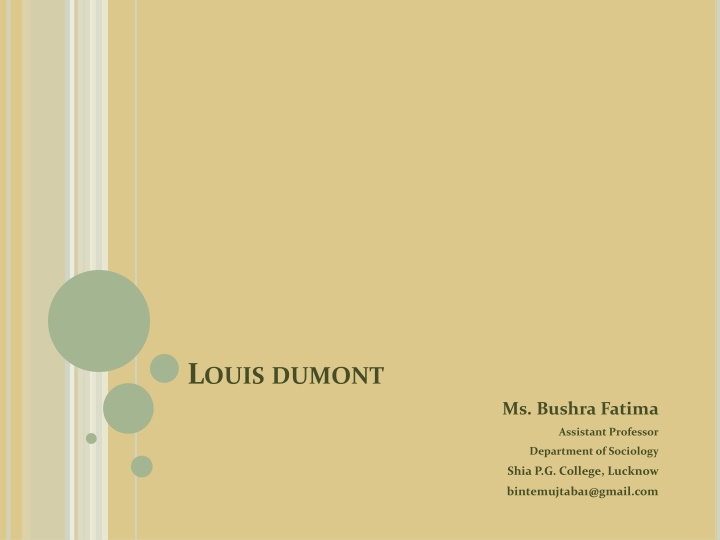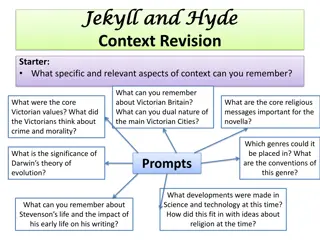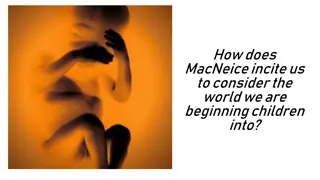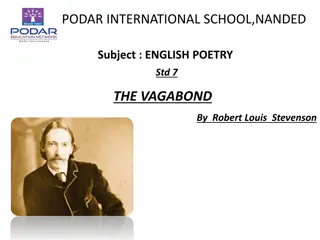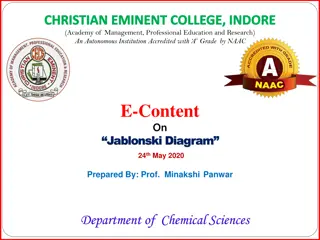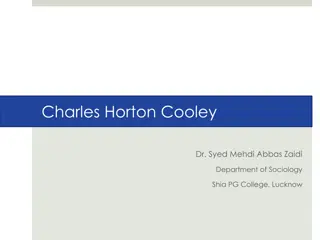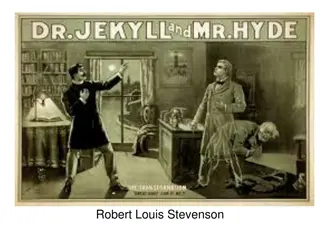Louis Dumont: Eminent Sociologist and Indologist
Louis Dumont (1911-1998) was a prominent figure in sociology and anthropology, focusing on India and the West. His major works include "Homo Hierarchicus," "Hierarchy and Marriage Alliance in South Indian Kinship," and more. Dumont's main contribution lies in his methodological perspective on the caste system, concept of pure and impure, and theory of varnas. He emphasized hierarchy as the core value in the caste system. Dumont's analysis reveals the intricate structure and characteristics of the caste system in India, highlighting separation, interdependence, and hierarchy among castes.
Download Presentation

Please find below an Image/Link to download the presentation.
The content on the website is provided AS IS for your information and personal use only. It may not be sold, licensed, or shared on other websites without obtaining consent from the author.If you encounter any issues during the download, it is possible that the publisher has removed the file from their server.
You are allowed to download the files provided on this website for personal or commercial use, subject to the condition that they are used lawfully. All files are the property of their respective owners.
The content on the website is provided AS IS for your information and personal use only. It may not be sold, licensed, or shared on other websites without obtaining consent from the author.
E N D
Presentation Transcript
LOUIS DUMONT Ms. Bushra Fatima Assistant Professor Department of Sociology Shia P.G. College, Lucknow bintemujtaba1@gmail.com
LOUIS DUMONT (1911- 1998) An eminent sociologist and Indologist, was a towering figure in the fields of sociology and anthropology in the world. His focus of debate has been India and the West. His exemplary studies are best on methodologies that he constructed for the study of particular societies and for inter-civilizational comparison.
LOUIS DUMONTS MAJOR WORK Hierarchy and Marriage Alliance in South Indian Kinship, 1957 Homo Hierarchicus: The Caste System and its Implications, 1966 (French), 1970 (English) PraMalai Kallar: A South Indian Sub-Caste, 1957 Religion, Politics, and History in India: Collected Papers in Indian Sociology, 1970 Homo Aequalis, 1977
MAIN CONTRIBUTION OF DUMONT Methodological perspective The Caste System Concept of Pure and Impure Theory of Varnas
THE CASTE SYSTEM Dumont says that caste is not a form of stratification but a special form of inequality, whose essence has to be deciphered by the sociologists. Here, Dumont identifies hierarchy as the essential value underlying the caste system, supported by Hinduism. Dumont starts with Bougie s definition of caste and says that it divides the whole Indian society into a larger number of hereditary groups distinguished from one another and connected together by three characteristics:
CONTINUUM Separation on the basis of rules of the caste in matters of marriage and contact, whether direct or indirect (food); Interdependent of work or division of labour, each group having, in theory or by tradition, a profession from which their members can depart only within certain limits; and Finally, gradation of status or hierarchy, which ranks the groups as relatively superior or inferior to one another. a) b) c)
CONTINUUM Dumont views that this definition indicates the main apparent characteristics of the caste system. He describes mainly three things: India is composed of many small territories and castes; Every caste is limited to particular and definite geographic area Marrying outside one s own caste is not possible in the caste system 1. 2. 3. Dumont views that this definition indicates the main apparent characteristics of the caste system. He describes mainly three things:
PURE-IMPURE His analysis is based on a single principle, i.e., the opposition of pure and impure. This opposition underlies hierarchy , which means superiority of the pure and inferiority of impure. This principle also underlies separation , which means pure and the impure must be kept separate. In the concept of pure and impure, Dumont had two questions in mind: Why is this distinction applied to hereditary groups? And, if it accounts for the contrast between Brahmins and untouchables, can it account equally for the division of society into a large number of groups, themselves sometime extremely sub- divided?
CONTINUUM The Brahmins, assigned with the priestly functions, occupied the top rank in the social hierarchy and were considered pure as compared to other castes, whereas the untouchables, being impure , and segregated outside the village, were not allowed to draw water from the same wells from which the Brahmins did so. Dumont categorized impurity into: temporary and permanent. Permanent Impurity: Untouchables are specialized in impure tasks, which lead to the attribution of a massive and permanent impurity to some categories of people. Temporary Impurity: In India, persons affected by this kind of event are treated as impure for a prescribed period.
BINARY OPPOSITION Hierarchy implies opposition between pure and impure, which also determines its dialectics. Caste Vs Non-Caste B.K.V.S / AS Priest Vs Non-Priest B / K.V.S Ruling Caste Vs Non-Ruling Caste K / B.V.S Business Caste Vs Service Caste V / S
CONTINUUM Pure Vs Impure B.K.V.S / AS B.K.V / S B.K / VS B / KVS
HOMO HIERARCHICUS This is a complete, theoretical work that helps us to access the vast body of available ethnographic data on caste. This work is different from others as it begins with a cardinal explanatory principle hierarchy. Hierarchy is said to distinguish Indian society from modern societies whose fundamental social principle is equality. The major theme of this review can be anticipated thus: any hierarchy, like any equalitarian system, is opposed by those who see its effect upon themselves as disadvantageous.
CONTINUUM Dumont finds traditional societies to be characterized by conception of the collective nature of man, by the primacy of social rather than individual goals, and thus by hierarchy (by which he means ritual hierarchy, based on the purity/pollution opposition). Modern societies are characterized contrastively by individualism and hence by egalitarianism (the antithesis of hierarchy). Dumant has called Indian society as Homo Major and Western Society as Homo Minor.
REFERENCE Mahajan, D. And Mahajan, K., Perspective on Indian Society Nagla, B.K., Indian Sociological Thought
